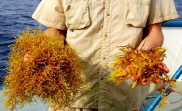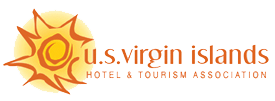US Virgin Islands Hotel & Tourism Association
 The USVI Hotel and Tourism Association and the Caribbean Hotel and Tourism Association are working together to provide hotels, government officials and stakeholders with best practice information aimed at mitigating the negative effects of high levels of Sargassum seaweed at local beaches. The organizations have released a resource guide, compiled by the Caribbean Alliance for Sustainable Tourism, a CHTA initiative in collaboration with strategic partner OBM International, to assist with local efforts.
The USVI Hotel and Tourism Association and the Caribbean Hotel and Tourism Association are working together to provide hotels, government officials and stakeholders with best practice information aimed at mitigating the negative effects of high levels of Sargassum seaweed at local beaches. The organizations have released a resource guide, compiled by the Caribbean Alliance for Sustainable Tourism, a CHTA initiative in collaboration with strategic partner OBM International, to assist with local efforts.
Sargassum is a free-floating seaweed that moves with the ocean currents. It serves as a habitat for over 250 species of fish and invertebrates and is used by marine life as nurseries, feeding grounds and shelter. Sargassum can also be extremely important to endangered and migratory species like sea turtles and whales.
“I am thrilled CHTA has put this guide together as many Caribbean islands are experiencing an influx of Sargassum. The best practices and mapping provided by CHTA are a valuable tool for educating both residents and visitors on how to manage and minimize the impact of Sargassum in an environmentally sensitive manner. Sargassum is a natural occurrence that poses no threat to beach goers,” said Lisa Hamilton, USVIHTA president.
“This initiative is a prime example of CHTA’s strategy to collectively share knowledge, experience and best practices in an effort to elevate Caribbean tourism across all islands,” said Emil Lee, president of CHTA.
“We are pleased to see various levels of government, hotel and community collaborations already underway to manage the Sargassum impact. Tackling this effectively requires an even greater collective effort, with government policies and resources coming into play,” states Lee. The guide recommends local stakeholders join forces and offers direction and resources to assist with their efforts.”
Removing Sargassum and Alternative Uses
Individuals are urged not to remove the Sargassum using cranes and mechanical equipment because sand is removed as well as any marine life living in the seaweed. Following is a list of some alternatives and cleaning methods being used around the Caribbean that have proven practical and economical:
- Leave or bury the Sargassum – Burying the Sargassum provides some relief as it works as an excellent medium for beach nourishment and can help combat beach erosion.
- Manually transport the Sargassum – Collect the seaweed from the beach with rakes using wheelbarrows for low to medium amounts which allows cleanup crews to be careful of sea turtle nests that can be damaged by mechanical equipment.
- Incorporate into landscaping – Sargassum can be reused once it is cleaned and dried, providing a nutrient-rich source of compost, fertilizer and weed control.
- Organize beach clean-ups – A community beach cleanup helps accomplish the task. Many recycling centers take bags of seaweed.
- Educating Residents and Businesses – It is important for the government to educate the residents and local businesses with reliable information to run a successful mitigation action plan.
- Incorporate Sargassum in culinary preparations – In some cases, Sargassum can be cooked in lemon juice or coconut milk though the seaweed must be thoroughly rinsed and cleaned to make sure any foreign debris is removed. The most popular preparation is a quick fry, followed by simmering in water, soy sauce and other ingredients.
- Contact local governments – Government officials should be contacted where there are amounts of Sargassum that are not manageable with the suggestion that it is treated as a natural disaster and government assistance be requested. Determination must be made as a nation if levels are considered to be a natural disaster and government assistance is necessary. This will be established on a case-by-case basis.
Guest Relations
Although Sargassum poses no known threat to humans, if not addressed promptly it is not a welcome sight and an odor can quickly set in. The guide recommends that hotels and governments create a fact sheet about Sargassum to educate visitors and residents about its importance to the ecosystem and the logic behind removing it in an environmentally safe manner.
CHTA has put together a guide, which also provides a link to an online unique Sargassum tracking system through the SEAS program that assists with predicting where the seaweed may come ashore. This allows managers to provide accurate reports to guests as well as planning for clean-ups. Sargassum: A Resource Guide for the Caribbean can be found on CHTA’s website at www.caribbeanhotelandtourism.com/CAST.php.
In addition, CHTA members participated in a webinar hosted by CAST and CHTA on July 21. The webinar addressed how hotel and tourism associations, governments, environmental groups and motivated citizens can come together to affect change. The webinar was such a success, that CHTA has made the information available to all members. Click here to download the complete presentation.
